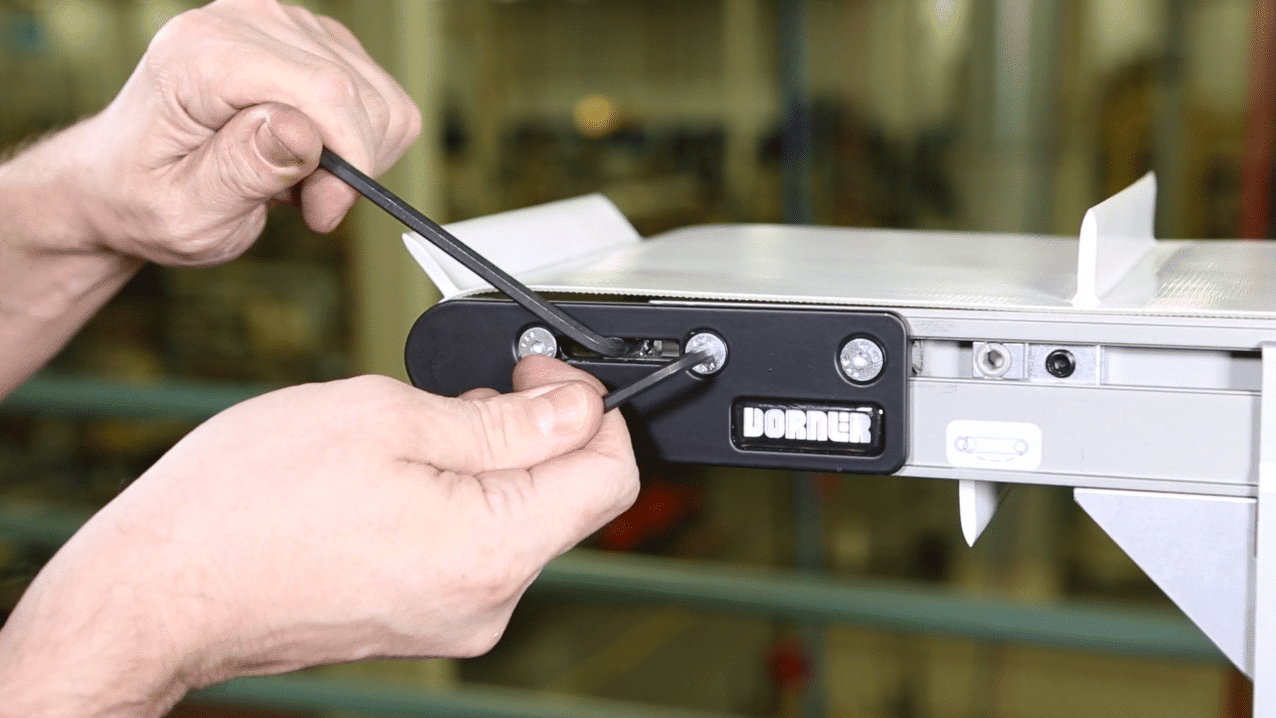
Properly tensioned belts are essential for the efficient operation of a conveyor system. A belt that is too loose or too tight can cause damage to the belt and/or other components on the conveyor, resulting in costly downtime and repair.
What is the Proper Belt Tension for Your Conveyor?
To ensure maximum productivity and efficiency of your conveyor system, the optimal belt tension should be set at a level that will not cause any slippage without sacrificing performance. In most cases, the ideal belt tension is the lowest possible (to reduce wear and tear) that doesn’t cause slippage.
Keep Reading: Precision Conveyor Belting – Proper Fit is Critical
Belt Tension Vs Tracking
While tension refers to the tightness of the belt, tracking refers to the alignment of the conveyor belt in relation to the pulleys. It is important to note that proper tension and tracking go hand-in-hand. If there is not enough tension, then it will be difficult to keep your belt on track. Too much tension, on the other hand, can cause strain on the conveyance system, including the pulleys and idlers.
Signs That Your Belt Tension is Off
Generally, you’ll be able to tell if your belt is not tensioned properly by simply paying attention to it and identifying abnormalities. When the tension of your conveyor belt isn’t correct or the belt isn’t tracking properly, you might experience the following issues:
- Frequent stalling
- Belt slippage
- Frayed belt lacing
- Belt edges curling or cupping
- Uneven wear on the belt edges
- Squealing or grinding noises when in use
- Regular misalignment of the belt
- Finding belt residue beneath the machine
If you notice these issues, you should check the tension of your conveyor belt. Chances are, it is either too tight or too loose and should be adjusted immediately to prevent any further damage.
Adjusting the Tension of Your Conveyor Belt: Common Tensioning Methods
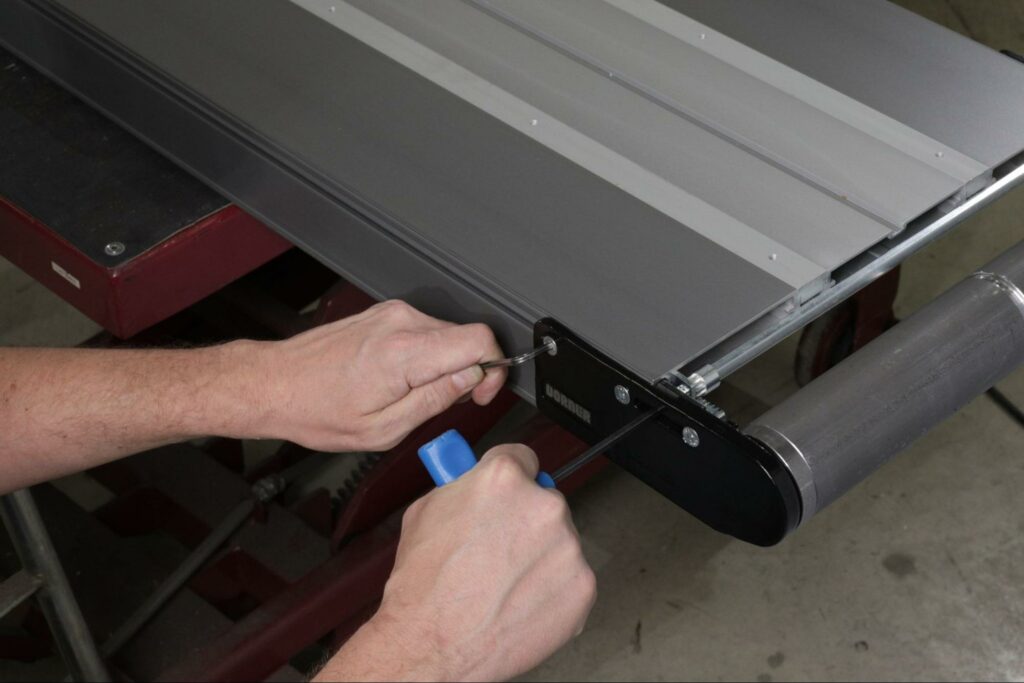
Depending on the type of conveyor, there are a few different tensioning methods you can use to adjust the belt tension. These include:
Jack-Screw Tension
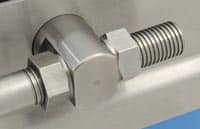 The most common method is jack-screw tensioning, which entails turning the screw at the end of your conveyor, pushing the bearing block toward the end and adding tension to the belt. You’ll find identical jack-screws at each end of a roller, and this method must be equally performed on both. This method is also used for belt tracking.
The most common method is jack-screw tensioning, which entails turning the screw at the end of your conveyor, pushing the bearing block toward the end and adding tension to the belt. You’ll find identical jack-screws at each end of a roller, and this method must be equally performed on both. This method is also used for belt tracking.
While simple, jack-screw tensioning also presents a number of disadvantages, including an increased risk of over-tensioning and extended maintenance time. The jack-screw can also be difficult to access and adjust, and this method doesn’t account for belt stretch over time, requiring regular adjustments for belt tensioning and tracking.
Tip-up Tail Tension
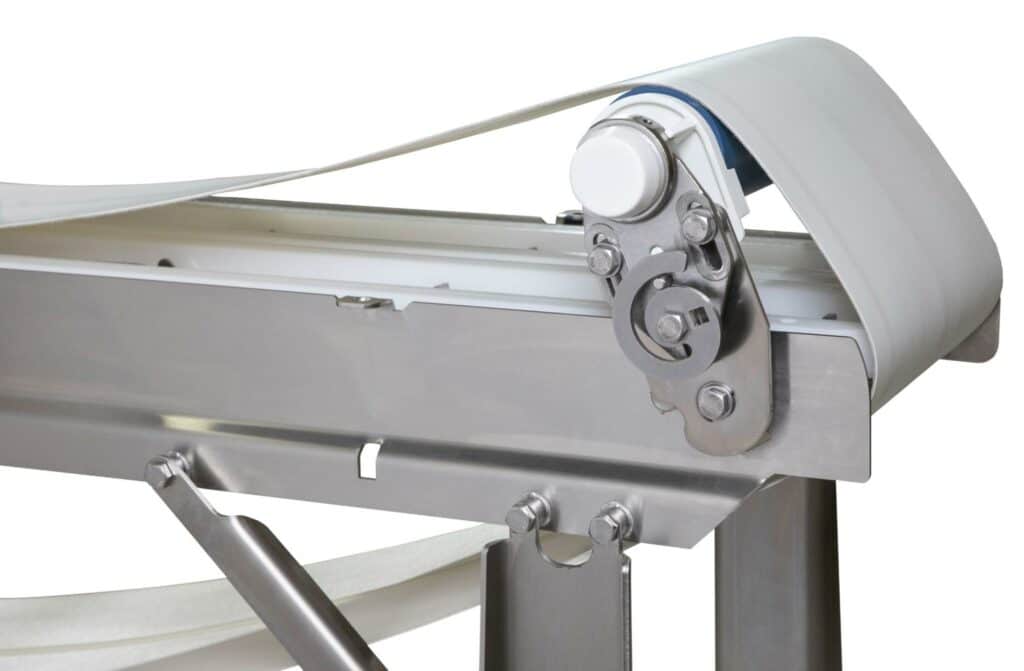 This tensioning method requires an operator to place the end roller of the conveyor on a pivot mechanism, which lifts the roller above the frame, extending it to add tension to the belt. Because this method can only be set to a single position, adjustment is necessary over time. A jack-screw or alternative device can be used to adjust the tension and tracking over time.
This tensioning method requires an operator to place the end roller of the conveyor on a pivot mechanism, which lifts the roller above the frame, extending it to add tension to the belt. Because this method can only be set to a single position, adjustment is necessary over time. A jack-screw or alternative device can be used to adjust the tension and tracking over time.
Tip-up tail tensioning is primarily used for initial tensioning, not adjustments, and it must be installed precisely prior to use for the best results.
Pneumatic or Spring Tension
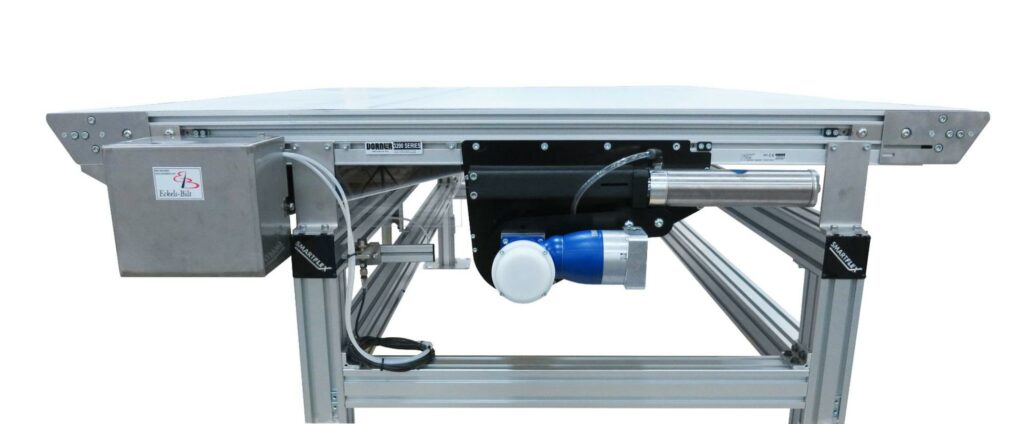 Primarily used for longer or heavy-duty conveyors, pneumatic or spring tensioning uses three or more additional rollers installed on the underside of the conveyor. By connecting a pneumatic cylinder (or other spring-loaded device) to the rollers, this method adds tension to the belt, moving the ends of the lower tension roller equally for consistent, parallel tensioning.
Primarily used for longer or heavy-duty conveyors, pneumatic or spring tensioning uses three or more additional rollers installed on the underside of the conveyor. By connecting a pneumatic cylinder (or other spring-loaded device) to the rollers, this method adds tension to the belt, moving the ends of the lower tension roller equally for consistent, parallel tensioning.
Compared to the previous belt tensioning methods described, this method accounts for belt stretch, adapting over time as needed without requiring manual adjustment, making it best suited for longer and heavier-load-bearing conveyor systems.
Rack and Pinion Tension
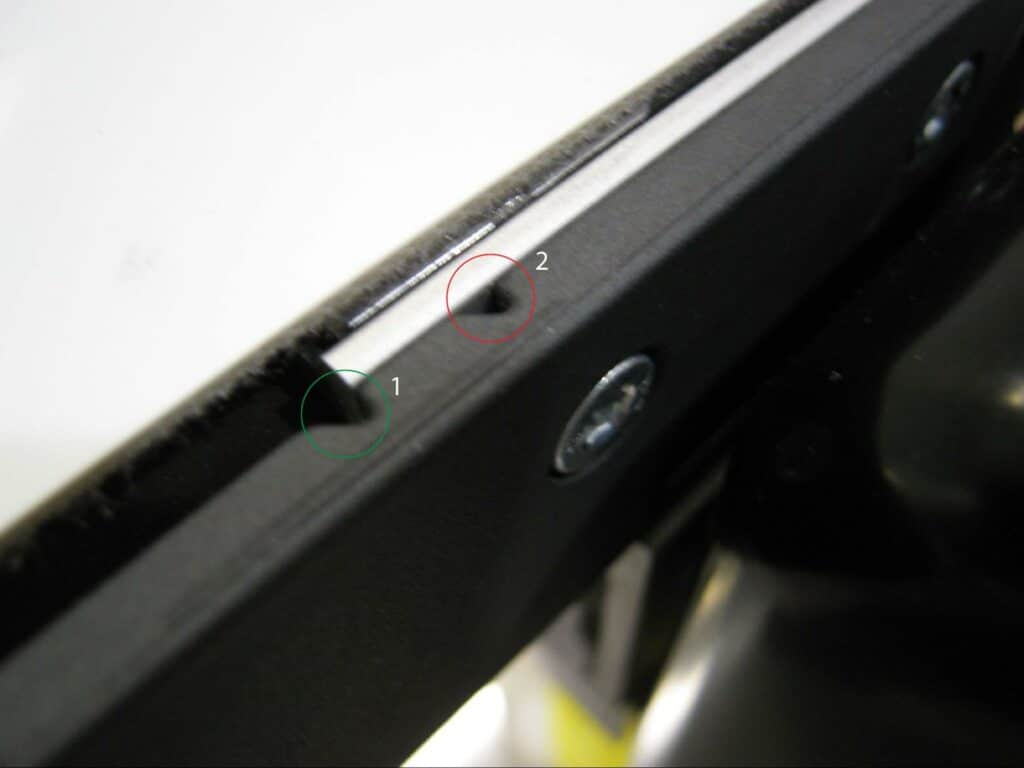 The rack and pinion tensioning method provides a compact and easy-to-access way to properly tension a conveyor belt. This method entails installing a rack and pinion device to the side of the conveyor frame, allowing the operator to hand-tighten the belt in a way that does not affect belt tracking and presents minimal risk of over-tensioning.
The rack and pinion tensioning method provides a compact and easy-to-access way to properly tension a conveyor belt. This method entails installing a rack and pinion device to the side of the conveyor frame, allowing the operator to hand-tighten the belt in a way that does not affect belt tracking and presents minimal risk of over-tensioning.
The rack and pinion tensioning from Dorner provides two notches that serve as guides; ideally, operators will be able to tighten their belt so that the frame aligns with the first notch, but if the belt must be tightened further to the second notch, that is a good indicator that the belt will need to be replaced soon.
Because this method requires manual tensioning, it does not automatically accommodate for belt stretch over time, meaning an operator will have to routinely re-tension to belt to ensure optimal performance and belt health.
Keep Reading: Belt Tensioning Methods for Small Package Conveyors
How to Ensure Your Conveyor Runs Smoothly
![]()
For optimal conveyor performance, you must ensure that your belt is tensioned and tracked properly, making adjustments as needed to avoid excessive wear and tear and prevent unnecessary repairs or replacements.
Additionally, taking the following proactive steps can keep your conveyor in top shape and running smoothly:
Perform Routine Inspections and Maintenance
Regularly inspect your conveyor belt for any signs of damage or wear, and proactively repair any issues that arise to prevent further problems. It is advisable to perform comprehensive inspections at least once a year to prolong the life of your conveyor.
Keep Conveyors Clean
Cleaning your conveyor belt and its components on a regular basis helps to prevent debris buildup and potential damage to the system. If any of the parts in your conveyor system are worn or damaged, it’s important to replace them as soon as possible. This includes replacing worn-out belts, rollers, and pulleys to avoid overworking other components and reduce the risk of breakdown.
Be Mindful of Belt Capacity
To avoid overloading your conveyor belt and damaging the system, always be mindful of its load capacity and speed settings. Exceeding the belt’s load capacity or running it faster than recommended can lead to serious issues, including breakages and excessive wear and tear.
Need Assistance With Your Conveyor Belt Tension? We Can Help!
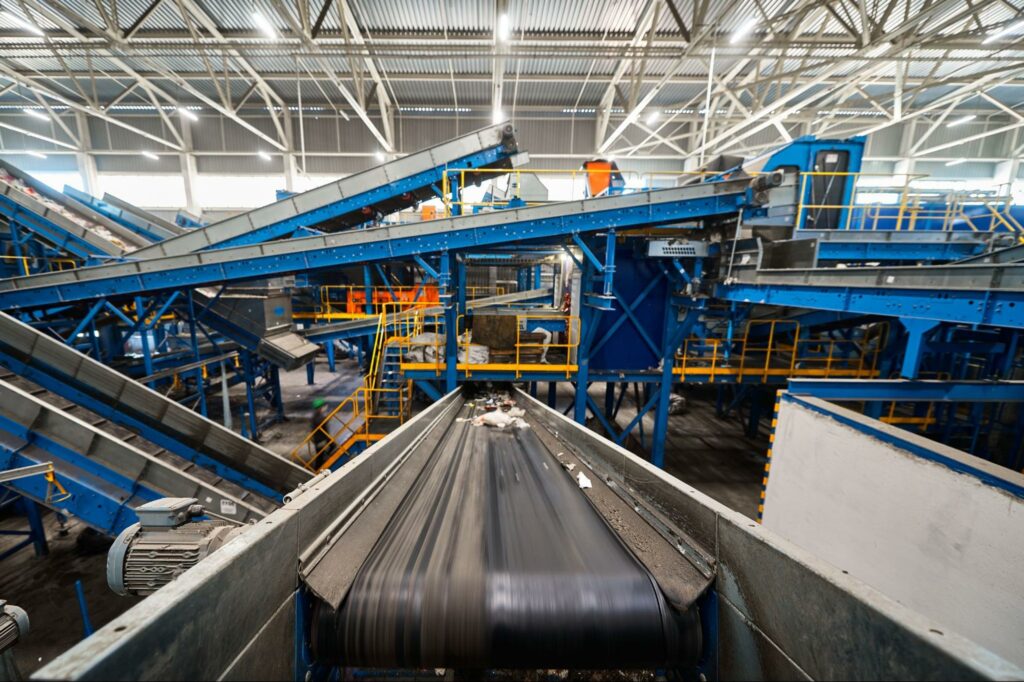
At Dorner Conveyors, we offer custom solutions that are tailored to your specific needs, ensuring optimal performance and longevity for your conveyor system. Whether you need help with belt tensioning, installation, repairs, or maintenance, our team of experienced technicians can help you get the job done.
Contact us today to learn more about our custom conveyor systems and how we can help you!





